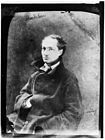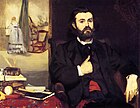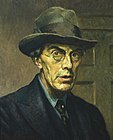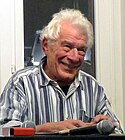Սևագիր:Արվեստի քննադատ
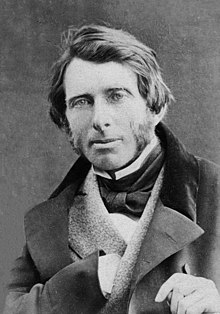
Արվեստի քննադատ, մարդ ով մասնագիտացած է արվեստը վերլուծելու, մեկնաբանելու և գնահատելու մեջ:Նրանց գրաքննադատությունները կամ ակնարկները նպաստում են արվեստի քննադատությանը, և դրանք հրապարակվում են թերթերում, ամսագրերում, գրքերում, ցուցահանդեսային բրոշյուրներում, կատալոգներում և կայքերում: Ներկայիս արվեստի քննադատներից ոմանք օգտագործում են արվեստի բլոգներ և այլ առցանց հարթակներ՝ ավելի լայն լսարանի հետ կապ հաստատելու և բանավեճն ընդլայնելու համար:
Կարծիքներ
[խմբագրել | խմբագրել կոդը]Ի տարբերություն արվեստագիտության, արվեստի քննադատների համար սովորաբար ինստիտուցիոնալ ուսուցում չկա: Արվեստի քննադատները տարբեր մասնագիտական ճանապարհ ունեն և կարող են ունենալ կամ չունենալ համալսարանական կրթություն[2]։ Պրոֆեսիոնալ արվեստի քննադատներից ակնկալվում է, որ գնահատող հայացք ունենան արվեստի նկատմամբ և արվեստի պատմության խորը գիտելիքներ: Սովորաբար արվեստաբանը դիտում է արվեստը գեղարվեստական ցուցահանդեսներում, պատկերասրահներում, թանգարաններում կամ արվեստանոցներում, և նրանք կարող են լինել Արվեստի քննադատների միջազգային ասոցիացիայի անդամներ, որն ունի ազգային բաժիններ[3]։ Շատ հազվադեպ են արվեստաբաններն իրենց ապրուստը վաստակում քննադատություն գրելով:
Արվեստաբանների կարծիքները արվեստին առնչվող թեմաների շուրջ բանավեճեր հրահրելու ներուժ ունեն: Սրա միջոցով արվեստաբանների տեսակետները, ովքեր գրում են արվեստի հրատարակությունների և թերթերի համար, հարստացնում են արվեստի և մշակույթի վերաբերյալ հանրային դիսկուրսը: Կոլեկցիոներներն ու հովանավորները հաճախ ապավինում են նման քննադատների խորհուրդներին՝ որպես միջոց՝ բարձրացնելու իրենց գնահատականը արվեստի հանդեպ, որը նրանք դիտում են: Ներկայիս շատ հայտնի և սիրված արվեստագետներ չէին ճանաչվում իրենց ժամանակի արվեստաբանների կողմից, հաճախ այն պատճառով, որ նրանց արվեստը դեռևս չհասկացված կամ չսիրված ոճի մեջ էր։ Conversely, some critics have become particularly important helping to explain and promote new art movements – Roger Fry with the Post-Impressionist movement and Lawrence Alloway with pop art as examples.
Controversies
[խմբագրել | խմբագրել կոդը]According to James Elkins[4] there is a distinction between art criticism and art history based on institutional, contextual, and commercial criteria; the history of art criticism is taught in universities, but the practice of art criticism is excluded institutionally from academia. An experience-related article is Agnieszka Gratza.[5] Always according to James Elkins in smaller and developing countries, newspaper art criticism normally serves as art history. James Elkins's perspective portraits his personal link to art history and art historians and in What happened to art criticism he furthermore highlights the gap between art historians and art critics by suggesting that the first rarely cite the second as a source and that the second miss an academic discipline to refer to.[6]
Gallery
[խմբագրել | խմբագրել կոդը]Notable art critics
[խմբագրել | խմբագրել կոդը]Կաղապար:Main list Erik de Smedt
- Christopher Allen
- Lawrence Alloway
- Guillaume Apollinaire
- Zacharie Astruc
- Albert Aurier
- Charles Baudelaire
- Michael Baxandall
- Sister Wendy Beckett
- Clive Bell
- Andrew Berardini
- Bernard Berenson
- John Berger
- Vasily Botkin
- John Canaday
- Champfleury
- Kenneth Clark
- T. J. Clark
- Robert Coates
- Clarence Cook
- Douglas Cooper
- Royal Cortissoz
- Thomas Craven
- Arthur Danto
- G. Roger Denson
- Sergei Diaghilev
- Denis Diderot
- John Elderfield
- James Elkins
- Félix Fénéon
- Hal Foster
- Peter Frank
- Michael Fried
- B. H. Friedman
- Roger Fry
- Peter Fuller
- Théophile Gautier
- Stepan Gedeonov
- Gustave Geffroy
- Clement Greenberg
- Dmitry Grigorovich
- Boris Groys
- Ichirō Hariu
- Dave Hickey
- Robert Hughes
- Édouard Jaguer
- Michael Kimmelman
- Gottfried Knapp
- Hilton Kramer
- Rosalind E. Krauss
- R. Siva Kumar
- Donald Kuspit
- Julien Leclercq
- Louis Leroy
- Lucy R. Lippard
- Giovanni Lista
- George Loukomski
- Sergey Makovsky
- Nancy Marmer
- Camille Mauclair
- Octave Mirbeau
- Robert C. Morgan
- Suzanne Muchnic
- John Neal
- Linda Nochlin
- Frank O'Hara
- Saul Ostrow
- Jed Perl
- Adrian Prakhov
- Griselda Pollock
- Nikolay Punin
- Arlene Raven
- Herbert Read
- Pierre Restany
- John Rewald
- Rainer Maria Rilke
- Daniel Robbins
- Barbara Rose
- Harold Rosenberg
- Robert Rosenblum
- John Ruskin
- John Russell
- Frank Rutter
- André Salmon
- Jerry Saltz
- Irving Sandler
- Meyer Schapiro
- Peter Schjeldahl
- Brian Sewell
- Roberta Smith
- Rafael Squirru
- Vladimir Stasov
- Leo Stein
- Leo Steinberg
- Aleksey Suvorin
- Michel Tapié
- Théophile Thoré-Bürger
- Éric Troncy
- Tristan Tzara
- Kirk Varnedoe
- Louis Vauxcelles
- Boris Vipper
- Karen Wilkin
- Émile Zola
- Ticio Escobar
See also
[խմբագրել | խմբագրել կոդը]References
[խմբագրել | խմբագրել կոդը]- ↑ «Turner Whistler Monet». Tate. Արխիվացված է օրիգինալից 2012-01-12-ին. Վերցված է 2009-04-12-ին.
- ↑ James Elkins, What happened to art criticism, Prickley Paradigm Press, 2003, p. 8.
- ↑ «Organisation Chart 2012–2013 – AICA international». Արխիվացված է օրիգինալից 2013-12-12-ին. Վերցված է 2013-12-12-ին.
- ↑ James Elkins, "Introduction" in Is Art History Global?, dir. James Elkins, Routledge Taylor & Francis Group, 2007, pp. 5–15.
- ↑ Gratza, Agnieszka (17 October 2013). «Frieze or faculty? One art critic's move from academia to journalism». The Guardian.
- ↑ James Elkins, What Happened to Art Criticism, Prickley Paradigm Press, 2003, pp. 4–5, 9.
- ↑ Edmond and Jules de Goncourt, French Eighteenth-Century Painters. Cornell Paperbacks, 1981, pp. 222–225. 0-8014-9218-1
- ↑ Dickson, Harold Edward (1943). Observations on American Art: Selections from the Writings of John Neal (1793–1876). State College, Pennsylvania: Pennsylvania State College. էջ ix.
- ↑ Sears, Donald A. (1978). John Neal. Boston, Massachusetts: Twayne Publishers. էջ 118. ISBN 080-5-7723-08.
- ↑ Joanna Richardson, Baudelaire, St. Martin's Press, New York, 1994, p. 191, 0-312-11476-1.
- ↑ J'accuse letter at French wikisource
- ↑ Lunn, Margaret Rauschenbach (15 October 1982). «G.-Albert Aurier, Critic and Theorist of Symbolist Art» (PDF) (PhD thesis). Massachusetts Institute of Technology. Արխիվացված է օրիգինալից (PDF) 4 June 2011-ին.
- ↑ Grayling, A.C; Goulder, Naomi; Pyle, Andrew, eds. (2006). Bell, Arthur Clive Heward – Oxford Reference (անգլերեն). doi:10.1093/acref/9780199754694.001.0001. ISBN 9780199754694. Վերցված է 2018-09-17-ին.
- ↑ Ian Chilvers, ed. (1990). «Fry, Roger». The Concise Oxford Dictionary of Art and Artists. Oxford and New York: Oxford University Press. էջ 169.
- ↑ [1], Refurbished Reputation for a Nervy Painter.
- ↑ From "A Short Chronology", in Donald Allen: The Collected Poems of Frank O'Hara.
- ↑ This theory has been described as an "influential theory about the nature of art", according to Philosophy Now, November 2013
- ↑ «John Berger obituary». The Guardian. 2 January 2017. Վերցված է 3 January 2017-ին.
- ↑ «I think the dead are with us": John Berger at 88». The New Statesman. 11 June 2015. Վերցված է 3 January 2017-ին.
Արտաքին հղումներ
[խմբագրել | խմբագրել կոդը]| Վիքիպահեստ նախագծում կարող եք այս նյութի վերաբերյալ հավելյալ պատկերազարդում գտնել Արվեստի քննադատ կատեգորիայում։ |



